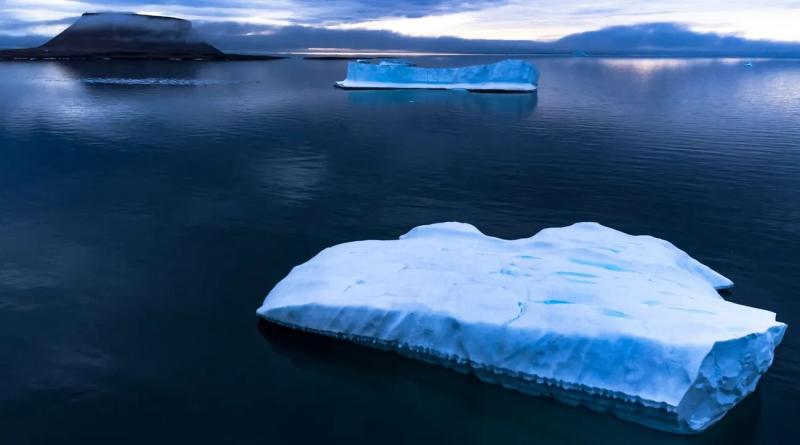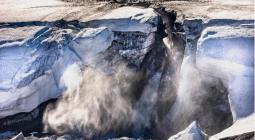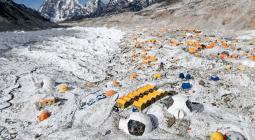Melting point: could ‘cloud brightening’ slow the thawing of the Arctic?

The climate emergency is prompting some scientists to suggest extreme measures. But whether you call it geoengineering or biomimicry, others feel interfering with nature will have too high a cost
Like the apocryphal frog that doesn’t notice the rising water temperature until it’s boiled alive, we as a global society are still struggling to recognise that anthropic global warming is hastening us towards irreversible environmental and ecological catastrophe. While there is consensus among climate scientists about the urgency of the situation, and widespread political acknowledgment that the use of carbon fuels must be reduced, targets have not been met and as the UK’s Cop26 president, Alok Sharma, said, the lack of progress at this month’s Cop27 demonstrates the 1.5C limit is on “life support” and there is growing evidence that we are further along the road to a tipping point than previously thought.
So advanced is this process that some scientists are beginning to argue that merely cutting carbon is not enough and an emergency measure involving what is known as geoengineering is called for. There have been a number of plans suggested, some more outlandish than others. They range from building giant mirrors in space to reflect away sunlight to painting the roofs of buildings white to help counteract heatwaves in cities.
One particular area of concern is the Arctic, which, according to the latest research by Norwegian scientists, is warming at four times the speed of the rest of the planet. The more it warms, the more ice cover it loses, which in turn leads to further heating, creating a so-called positive feedback loop (although, paradoxically, the effect is entirely negative).
Two suggestions for geoengineering the poles’ climate have drawn serious attention and have been the subject of theoretical modelling. The most popular and perhaps advanced of these is what is known as stratospheric aerosol injection, in which sulphur dioxide would be released into the stratosphere to gather around the poles. The idea is that the aerosols will have a similar effect to the ash clouds from volcanoes, which reach a high altitude and reflect sunlight, bringing down temperatures on Earth.
There are many critics of the proposal, who point out that sulphur dioxide, which is associated with acid rain, asthma and chronic bronchitis, is itself environmentally damaging and there is no guarantee that its effects would be limited to the poles or, indeed, what its long-term effects might be. There has been some very limited field work examining aerosol effects, but it has been too restricted to offer any definitive answers.
As Ben Kravitz, atmospheric scientist at Pacific Northwest National Laboratory, says: “It’s difficult for me to say whether I’m for or against stratospheric aerosol injection because it’s hard for me to even understand what I’m giving an opinion on. The effects will vary depending on how much aerosol injection is done, where, when and what material is used. And then we need to translate effects (such as changes in temperature, precipitation, etc) into impacts (such as food and water security). And then all of that needs to be compared to what would happen under climate change without stratospheric aerosol injection. So it’s too hard for me to say whether geoengineering is a good or bad idea at this stage.”
Aside from the inherent uncertainty in the proposal, there is also concern about the politics of geoengineering, particularly in relation to indigenous people in the Arctic region, with one group of scientists arguing that “solar geoengineering at planetary scale is not governable in a globally inclusive and just manner within the current international political system”.
A recent study led by Wake Smith, a lecturer at Yale University on venture capital and private equity, looked at the financial and logistical implications of aerosol injection deployment. The cost was estimated to be $11bn a year – no small sum, but a tiny fraction of the costs of dealing with damage done by climate change. The study suggested that 175,000 flights a year would be needed to release a cloud of microscopic sulphur dioxide particles at an altitude of 43,000ft and latitude of 60 degrees in each hemisphere.
Such a massive air mobilisation would in turn release millions of tonnes of carbon dioxide into the atmosphere, but it would also lead, say the models, to a 2C drop in temperature at the polar regions. Smith acknowledges that it’s a temporary measure that treats the symptoms rather than the underlying disease. “It’s aspirin, not penicillin,” he’s said. “It’s not a substitute for decarbonisation.”
In theory, the sulphur dioxide particles would settle over the poles, but in practice, no one can be sure. It’s one of the reasons that cloud brightening has been suggested as a less risky and more viable option.
Sir David King is the founder of the Centre for Climate Repair at Cambridge (CCRC). A multidisciplinary team, it has three main objectives: to reduce CO2 emissions, remove excess greenhouse gases from the atmosphere and to refreeze damaged parts of the climate system.
The CCRC is backing research into cloud brightening, which King insists is not geoengineering. “We reserve the phrase geoengineering for putting sulphates into the stratosphere,” he explains. While he is in favour of small-scale experiments with sulphates, he believes there should be a moratorium on “at scale” use of them in the stratosphere. Marine cloud brightening, by contrast, he says is not geoengineering but “biomimicry”, a means of imitating a natural process on a huge scale. The science is straightforward in theory.
Clouds formed over oceans tend to build around salt crystals left after droplets of sea spray evaporate. Salt crystals vary in size and if they are at the smaller end of the spectrum, then clouds are formed of lots of small droplets. Clouds made from smaller droplets appear whiter than those composed of larger droplets and as a result reflect more sunlight, even if they carry the same amount of water. The idea is to whiten clouds by creating sea spray with a flotilla of boats armed with pumps and nozzles.
“Once it’s all been proved operative and functional and there’s no deleterious effects,” says King, “we would need to have 500 to 1,000 ocean-going vessels placed around the Arctic Ocean.”
“I think marine cloud brightening is promising,” says Kravitz, “but there’s still a lot of research that needs to be done. Interactions between aerosols and clouds are the single largest source of uncertainty in climate science right now.” The procedure, should it take place, would be restricted to the Arctic and not repeated in the Antarctic.
“The North Pole is an ocean surrounded by land and the South Pole is land surrounded by ocean,” explains King. “So the melting ice of the West Antarctic ice sheet, which is looking pretty dangerous, is happening because of warm seawater coming between the land the ice is sitting on and the ice. The problem there is extraordinarily difficult to manage because what is happening in the Antarctic with this warming of oceans is directly related to what’s happening in the Arctic.”
He refers to the “overturning current”, or the Atlantic meridional overturning circulation, as it’s technically called, part of the system in which cold water is circulated and which is thought to have been weakened by climate change and may itself reach a tipping point. In any case, the weakening of the AMOC has led to warmer waters in the Antarctic.
To make the necessary tests and experiments, get agreements from native peoples, which is part of the CCRC’s plan, then design, build or fit out the vessels and implement the process seems like a monumental undertaking. It would require a unity of vision, large-scale fundraising, some agreed system of international governance and oversight and no doubt much else besides.
How long does King estimate it will take to become operational? He runs swiftly through the necessary hurdles to clear, chief of which is fundraising, which he says comes from individual philanthropists. He expects three to four years of experimentation, possibly with a vessel at sea, but it could also take place on land in Orkney.
“I hate to say this,” he warns, “but overall, it may be seven years before we are operating at anything like scale.”
Given that it seems to take about seven years to get planning permission for a loft conversion, this seems to me like an astonishingly optimistic timescale.
“Remember what I said,” he interrupts, when I voice my surprise, “the Arctic Circle is now heating up at four times the rate of the rest of the planet.”
He says his team is working very hard to get acceptability from potentially affected people, including the Inuit and Sami people. But it’s getting the starting money, which he estimates to be “a few billion pounds”, which will be most time-consuming. The vessels, he says, would be remotely controlled and, he hopes, will run on solar energy and the movement of seawater and wind.
“To scale up to 500 or 1,000 vessels,” he says, “would be in the region of £30bn to £40bn. Once we’ve got a few vessels built, it will all get a lot cheaper. The running costs may be £10bn a year. But compare this with the loss and damage [of the Arctic continuing to warm at its current rate].”
Without intervention, the melting of Greenland’s ice cap is irreversible, he says, which would eventually lead to an average global sea level rise of “seven metres”. And that’s not the only issue. There is a vast amount of methane stored in the permafrost on the landmass in the Arctic region, which King notes is beginning to be released by rising temperatures in Siberia. “If it was released over a 20-year period, global temperatures would rise by five to eight degrees centigrade,” he says.
The CCRC is talking to a number of governments, most prominently the Netherlands, which, given its reclaimed land and low-lying territory, is particularly concerned about managing rising sea levels. As he points out, though, few countries with significant coastlines are immune to the risks, including the UK.
Brightening clouds or suffusing the stratosphere with sulphur dioxide sound like science fiction answers to our carbon dependency. Neither addresses the underlying cause – they’re sticking plasters placed over gaping wounds, at best a breathing space, if you don’t mind breathing sulphur dioxide – to enable time to complete a transfer from fossil fuels.
But given the urgency of the situation, and the lack of effective global leadership in dealing with it, it seems sensible at least to test the efficacy of these stop-gap measures. Climate repair is not a one-method process. It will require innovation as well as abstinence. If the mimicking of the cycle by which microscopic salt crystals pick up water vapour can slow Arctic warming, then it will truly have produced clouds with a silver lining.
cover photo: Icebergs floating in Baffin Bay, Greenland in July 2022. the Arctic is warming at four times the speed of the rest of the planet, say scientists. Photograph: Kerem Yucel/AFP/Getty Images




